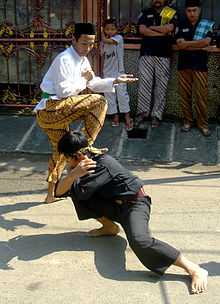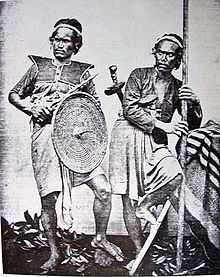Pencak Silat

Pencak silat (Indonesian pronunciation: [ˈpɛntʃaʔ ˈsilat]; sometimes spelled penchak silat or pentjak silat in Western writings) is an umbrella term for the martial arts of Indonesia.[1]
The leading organization of pencak silat in Indonesia is IPSI (Ikatan Pencak Silat Indonesia, meaning Pencak Silat Association of Indonesia). The liaison body for international pencak silat is the International Pencak Silat Association or PERSILAT (Persekutuan Pencak Silat Antara Bangsa).
Etymology
Although the word silat is widely known through much of South East Asia, the term pencak silat is specifically used in Indonesia. Pencak silat was chosen in 1948 as a unifying term for the Indonesian fighting styles. It was a compound of the two most commonly used words for martial arts in Indonesia. Pencak was the term used in central and east Java, while silat was used in Sumatra and Borneo. In modern usage, pencak and silat are seen as being two aspects of the same practice. Pencak is the performance aspects of the martial art, while silat is the essence of the fighting and self-defense. It is often said by practitioners that there can be no silat without pencak, on the other hand pencak without silat skills is purposeless.[2]
The origin of the words pencak and silat have not been proven. Some believe that pencak comes from the Sanskrit word pancha meaning five, or from the Chinese pencha meaning to avert or deflect.[3]
History
The pencak silat tradition is mostly oral, having been passed down almost entirely by word of mouth. In the absence of written records, much of its history is known only through myth and archaeological evidence. The earliest fighting arts in Indonesia can be traced back to prehistoric tribes. The primary weapons of Indonesia's tribal peoples were the single-edge sword, shield and javelin. The inhabitants of Nias Island had until the 20th century remained largely untouched by the outside world, however, they are culturally similar to the Himalayan Naga tribe. Neighbouring Sumatrans are said to have left the Nias people alone because they were fearless warriors.
India and China were the first civilizations from outside Southeast Asia with whom Indonesia made contact and both countries influenced the local culture, religion and martial arts.[1] Bas-reliefs in Srivijaya depict warriors wielding such weapons as the jian or Chinese straight sword, which is still used in some styles today.[1] Additionally, Javanese blades are of Indian derivation. The earliest evidence of silat being taught in a structured manner comes from the Sumatra-based empire of Srivijaya where folklore tells that it was created by a woman named Rama Sukana who witnessed a fight between a tiger and a large bird. By using the animals' movements, she was able to fend off a group of drunken men that attacked her. She then taught the techniques to her husband Rama Isruna from whom they were formally passed down. There are several variations of this story depending on the region where it is told. On the island of Boyan (Bawean), Rama Sukana is believed to have watched monkeys fighting each other while the Sundanese of West Java believe that she saw a monkey battle a tiger. The accuracy of this legend cannot be substantiated but the fact that silat is attributed to a woman is thought to indicate its age, considering the prominence of women in traditional Southeast Asian society.
While Srivijaya dominated the coastal areas, the Sailendra and Medang Kingdoms ruled central Java where the fighting arts developed in three geographical regions: West Java, Central Java, and East Java. Pencak silat especially flourished in Java which is now home to more different styles than any other Indonesian islands. In the 13th century, Srivijaya was defeated by the Cholas of south India. This was followed by the decline of the Sailendra and Sanjaya kingdoms but it also gave rise to the Majapahit empire. This was the first empire to unite all of Indonesia's major islands, and Javanese silat reached its peak under Majapahit. The influence of silat from the mainland was consolidated by Ninik Dato' Suri Diraja (1097–1198) to create silek or Minangkabau silat in Sumatra.[4]
Pencak silat was later used by freedom-fighters against Dutch colonists. During this time the Bugis and Makassar people from south Sulawesi were very well known as expert sailors, navigators and warriors. After Indonesia's independence, pencak silat adapted itself in the context of modern sport and, in some cases, religion.[5] It was eventually brought to Europe by Indo people of Eurasian (mixed Indonesian and European) ancestry, such as Paatje Phefferkorn.
Weapons
- Kris: A dagger, often with a wavy blade made by folding different types of metal together and then washing it in acid.
- Kujang: Sundanese blade roughly shaped like a deer's antler.
- Samping/Linso: Piece of silk fabric worn around the waist or shoulder, used in locking techniques and for defense against blades.
- Batang/Galah: Rod or staff made from wood, steel or bamboo.
- Cindai: Cloth, usually worn as sarong or wrapped as head gear.
- Tongkat/Toya: Walking-stick carried by the elderly and travelers.
- Kipas: Traditional folding fan preferably made of hardwood or iron.
- Kerambit/Kuku Machan: A blade shaped like a tiger's claw
- Sabit/Clurit: A sickle, commonly used in farming, cultivation and harvesting of crops.
- Sundang: A double edge Bugis sword, often wavy-bladed
- Rencong/Tumbuk Lada: Slightly curved Minang dagger, literally meaning "pepper crusher".
- Gedak: Mace or club made of steel.
- Tombak/Lembing: Spear or javelin made of bamboo, steel or wood that sometimes has horsehair attached near the blade.
- Parang/Golok: Machete or broadsword, commonly used in daily tasks such as cutting through forest brush.
- Trisula: A trident or 3-pronged spear
- Chabang/Cabang: Short-handled trident, literally meaning "branch"
International competitions

The major international competition is Pencak Silat World Championship, organised by PERSILAT.[6] This competition takes place every 2 or 3 years period. More than 30 national teams competed in the latest tournament in Jakarta, 12–17 December 2010.
List of Pencak Silat World Championships
| Championship | Year | Host | Nations | Events |
|---|---|---|---|---|
| I | 1982 | 7 | ||
| II | 1984 | 9 | ||
| III | 1986 | 14 | ||
| IV | 1987 | 18 | ||
| V | 1988 | 18 | ||
| VI | 1990 | 18 | ||
| VII | 1992 | 20 | ||
| VIII | 1994 | 19 | ||
| IX | 1997 | 20 | ||
| X | 2000 | 20 | ||
| XI | 2002 | 19 | ||
| XII | 2004 | 20 | ||
| XIII | 2007 | 26 | ||
| XIV | 2010 | 32 | 23 | |
| XV | 2012 | ? | ||
| XVI | 2015 | 37 | 37 |
All-medal table
| Rank | Nation | Gold | Silver | Bronze | Total |
|---|---|---|---|---|---|
| 1 | | 12 | 7 | 16 | 35 |
| 2 | | 9 | 4 | 8 | 21 |
| 3 | | 7 | 4 | 14 | 23 |
| 4 | | 8 | 3 | 9 | 20 |
| 5 | | 4 | 8 | 5 | 17 |
| 6 | | 3 | 7 | 7 | 17 |
| 7 | | 3 | 4 | 6 | 13 |
| 8 | | 2 | 5 | 9 | 16 |
| 9 | | 2 | 6 | 11 | 19 |
| 10 | | 2 | 1 | 4 | 7 |
| 11 | | 1 | 2 | 4 | 7 |
| 12 | | 0 | 4 | 4 | 8 |
| 13 | | 0 | 4 | 1 | 5 |
| 14 | | 0 | 3 | 2 | 5 |
| 15 | | 0 | 2 | 1 | 3 |
| Total | 53 | 65 | 92 | 212 | |
See also
References
- ↑ 1.0 1.1 1.2 Donn F. Draeger (1992). Weapons and fighting arts of Indonesia. Rutland, Vt. : Charles E. Tuttle Co. ISBN 978-0-8048-1716-5.
- ↑ Howard Alexander, Quintin Chambers, Donn F. Draeger (1979). Pentjak Silat: The Indonesian Fighting Art. Tokyo, Japan : Kodansha International Ltd.
- ↑ Sheikh Shamsuddin (2005). The Malay Art Of Self-defense: Silat Seni Gayong. North Atlantic Books. ISBN 1-55643-562-2.
- ↑ Thesis: Seni Silat Melayu by Abd Rahman Ismail (USM 2005 matter 188)
- ↑ Uwe Patzold (2011). Self-Defense and Music in Muslim Context in West Java in Divine Inspirations: Music and Islam in Indonesia. Oxford, UK : Oxford University Press. ISBN 978-0-19-538541-0.
- ↑ "International Pencak Silat Competition Regulations". PERSILAT. 2004. Retrieved 2010-12-21.
Further reading
- Quintin Chambers and Donn F. Draeger (1979). Javanese Silat: The Fighting Art of Perisai Diri. ISBN 0-87011-353-4.
- Sean Stark (2007). Pencak Silat Pertempuran: Vol. 1. Stark Publishing. ISBN 978-0-615-13968-5.
- Sean Stark (2007). Pencak Silat Pertempuran: Vol. 2. Stark Publishing. ISBN 978-0-615-13784-1.
- O'ong Maryono] (2002). Pencak Silat in the Indonesian Archipelago. ISBN 9799341604.
- Suwanda, Herman (2006). Pencak Silat Through my eyes. Los Angeles: Empire Books. p. 97. ISBN 9781933901039.
- Mason, P.H. (2012) "A Barometer of Modernity: Village performances in the highlands of West Sumatra," ACCESS: Critical Perspectives on Communication, Cultural & Policy Studies, 31(2), 79-90.
External links
| Wikimedia Commons has media related to Pencak Silat. |
- Official website of PERSILAT, the Pencak Silat World Federation
- A collection of essays on Pencak Silat by O'ong Maryono.
- Culture Silat - Seni Gayung Fatani Malaysia (french).
- Music for the Fight, Movements for the Soul
| |||||||||||||||||||||||||||||||||||||||||||||
| ||||||||||||||||||||||||||||||||||||||||||||||||||||||

